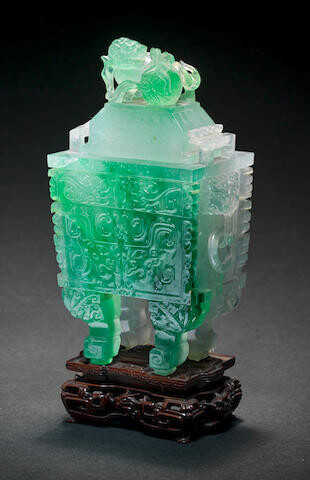A SUPERB JADEITE ARCHAISTIC INCENSE BURNER AND COVER, FANGDING
Qianlong seal mark, late Qing Dynasty
Qianlong seal mark, late Qing Dynasty
Of archaistic form, crisply carved with taotie masks on the straight sides, the corners with flanges, set with a pair of mythical-beast-head handles suspending loose rings, all supported on four cabriole feet, the rim with a pair of square arched handles, the cover surmounted by a Buddhist lion, the stone of vibrant apple-green tone on one side and attractive translucent frost-white tone on the others, hardwood stand. 13.3cm (5 1/4in) high. (3).
清晚期 翡翠饕餮紋獅鈕活環耳方鼎
「乾隆年製」篆書刻款
Provenance:
Parry Collection, London, and thence by descent
來源:
倫敦Parry家族收藏,並由後人保存迄今
Meticulously carved in the archaistic shape of a food vessel, the present lot is a remarkable example of jadeite carving displaying the lapidary craftsman's ability to emphasise the finest qualities of the jadeite stone and its high degree of frost-like translucency through the elaborate archaistic designs of taotie masks and auspicious creatures.
The fangding shape and decorative designs of the present vessel, including the taotie masks, ring-handles and stylised dragons, are all inspired by early bronze ritual food vessels, which were made during the Shang and Zhou dynasties. For an example of an archaic bronze fangding, Shang dynasty, in the Qing Court Collection, see Bronzes in the Palace Museum, Beijing, 1999, p.51, no.22.
The archaistic style recalls the Qianlong Emperor's fascination with antiquity and archaism. Proposing to 'restore ancient ways', referring to the view of ancient culture as having intrinsic qualities of sincerity, simplicity and happy exuberance, the Emperor instructed the Court to collect drawings of antiquities, such as the 'Catalogue of Xiqing Antiquities' Xi Qing Gu Jian, compiled in 1755, which provided the craftsmen with a source of inspiration in jade carving; see Chang Li-tuan, The Refined Taste of the Emperor: Special Exhibition of Archaic and Pictorial Jades of the Ch'ing Court, Taipei, 1997, pp.49-50.
See two related examples of jadeite archaistic fangding and covers in the Metropolitan Museum of Art, New York, the first, Qing dynasty (dated as Qianlong), and the second, a larger example, Qing dynasty, illustrated by H.R.Bishop, The Heber R. Bishop Collection of Jade and other Hard Stones, Handbook no.10, New York, 1909, pp.42 and 51 (acc.no.02.18.499a,b; and acc.no.02.18.428a,b). See also an archaistic jadeite fangding and cover, 19th century, in the Fitzwilliam Museum, Cambridge, illustrated by J.C.S.Lin, The Immortal Stone: Chinese Jades from the Neolithic to the Twentieth Century, Cambridge, 2009, p.123.
A related but larger (18.5cm high) jadeite archaistic vessel and cover, fangding, late Qing dynasty, and a jadeite archaistic wine cup, jue, late Qing dynasty/early 20th century, were sold at Christie's, Hong Kong, 30 May 2012, lots 4275 and 4276. A jadeite archaistic censer and cover, 19th century, was sold at Sotheby's London, 10 November 2010, lot 116.
以翡翠大料剖制琢成,長方形,雙沖耳,口下漸收,下承四夔龍足。有蓋,蓋面隆起,蓋頂雕獅戲繡球為鈕。腹部浮雕饕餮紋,兩側雕獅首銜環耳,雕工精湛,古樸莊重。玉材選料考究,質地明淨細膩,晶瑩剔透,種水上乘,且色澤尤為殊妙,器身正面翠色,碧綠濃艷,背面半透明,清和溫潤,白綠兩色相互映襯,相得益彰。
本例器形及紋飾源自商周青銅器方鼎。清代皇室承接了明代的宮廷收藏,其中包括大量高古青銅器;如清宮舊藏一例商代青銅鼎,收錄於《故宮青銅器》,北京,1999年,頁51,編號22。乾隆皇帝十分推崇自古物中取材器物造型與設計,其慕古之情對清代裝飾藝術之影響甚深。乾隆十四年,乾隆皇帝諭令將內府庋藏的鼎、尊、彝等青銅器分門別類,仿效《考古圖》、《宣和博古圖》體例薈輯成《西清古鑑》,成為當時有史以來規模最大的古銅器圖譜,相關討論可參見張麗端《宮廷之雅:清代仿古及畫意玉器特展圖錄》,台北,1997,頁49-50。
紐約大都會藝術博物館館藏兩例清代翡翠仿古紋方蓋鼎,藏品編號02.18.499a,b與02.18.428a,b,收錄於H.R.Bishop著,《The Heber R. Bishop Collection of Jade and other Hard Stones》,手冊10,紐約,1909年,頁42與51。另見劍橋大學菲茨威廉博物館館藏一例十九世紀翡翠方鼎,收錄於J.C.S.Lin著,《The Immortal Stone: Chinese Jades from the Neolithic to the Twentieth Century》,劍橋,2009年,頁123。
參考一例清晚期翠玉饕餮紋獅鈕活環耳方鼎,較本例形制相仿惟體積稍大(通高18.5厘米),及一例清晚期翠玉雕獸面紋爵,同售於香港佳士得,2012年5月30日,拍品編號4275與4276。倫敦蘇富比亦曾售一例十九世紀翡翠仿古紋香爐,2010年11月10日,拍品編號116,可為比對。
View it on
Sale price
Estimate
Time, Location
Auction House
Qianlong seal mark, late Qing Dynasty
Qianlong seal mark, late Qing Dynasty
Of archaistic form, crisply carved with taotie masks on the straight sides, the corners with flanges, set with a pair of mythical-beast-head handles suspending loose rings, all supported on four cabriole feet, the rim with a pair of square arched handles, the cover surmounted by a Buddhist lion, the stone of vibrant apple-green tone on one side and attractive translucent frost-white tone on the others, hardwood stand. 13.3cm (5 1/4in) high. (3).
清晚期 翡翠饕餮紋獅鈕活環耳方鼎
「乾隆年製」篆書刻款
Provenance:
Parry Collection, London, and thence by descent
來源:
倫敦Parry家族收藏,並由後人保存迄今
Meticulously carved in the archaistic shape of a food vessel, the present lot is a remarkable example of jadeite carving displaying the lapidary craftsman's ability to emphasise the finest qualities of the jadeite stone and its high degree of frost-like translucency through the elaborate archaistic designs of taotie masks and auspicious creatures.
The fangding shape and decorative designs of the present vessel, including the taotie masks, ring-handles and stylised dragons, are all inspired by early bronze ritual food vessels, which were made during the Shang and Zhou dynasties. For an example of an archaic bronze fangding, Shang dynasty, in the Qing Court Collection, see Bronzes in the Palace Museum, Beijing, 1999, p.51, no.22.
The archaistic style recalls the Qianlong Emperor's fascination with antiquity and archaism. Proposing to 'restore ancient ways', referring to the view of ancient culture as having intrinsic qualities of sincerity, simplicity and happy exuberance, the Emperor instructed the Court to collect drawings of antiquities, such as the 'Catalogue of Xiqing Antiquities' Xi Qing Gu Jian, compiled in 1755, which provided the craftsmen with a source of inspiration in jade carving; see Chang Li-tuan, The Refined Taste of the Emperor: Special Exhibition of Archaic and Pictorial Jades of the Ch'ing Court, Taipei, 1997, pp.49-50.
See two related examples of jadeite archaistic fangding and covers in the Metropolitan Museum of Art, New York, the first, Qing dynasty (dated as Qianlong), and the second, a larger example, Qing dynasty, illustrated by H.R.Bishop, The Heber R. Bishop Collection of Jade and other Hard Stones, Handbook no.10, New York, 1909, pp.42 and 51 (acc.no.02.18.499a,b; and acc.no.02.18.428a,b). See also an archaistic jadeite fangding and cover, 19th century, in the Fitzwilliam Museum, Cambridge, illustrated by J.C.S.Lin, The Immortal Stone: Chinese Jades from the Neolithic to the Twentieth Century, Cambridge, 2009, p.123.
A related but larger (18.5cm high) jadeite archaistic vessel and cover, fangding, late Qing dynasty, and a jadeite archaistic wine cup, jue, late Qing dynasty/early 20th century, were sold at Christie's, Hong Kong, 30 May 2012, lots 4275 and 4276. A jadeite archaistic censer and cover, 19th century, was sold at Sotheby's London, 10 November 2010, lot 116.
以翡翠大料剖制琢成,長方形,雙沖耳,口下漸收,下承四夔龍足。有蓋,蓋面隆起,蓋頂雕獅戲繡球為鈕。腹部浮雕饕餮紋,兩側雕獅首銜環耳,雕工精湛,古樸莊重。玉材選料考究,質地明淨細膩,晶瑩剔透,種水上乘,且色澤尤為殊妙,器身正面翠色,碧綠濃艷,背面半透明,清和溫潤,白綠兩色相互映襯,相得益彰。
本例器形及紋飾源自商周青銅器方鼎。清代皇室承接了明代的宮廷收藏,其中包括大量高古青銅器;如清宮舊藏一例商代青銅鼎,收錄於《故宮青銅器》,北京,1999年,頁51,編號22。乾隆皇帝十分推崇自古物中取材器物造型與設計,其慕古之情對清代裝飾藝術之影響甚深。乾隆十四年,乾隆皇帝諭令將內府庋藏的鼎、尊、彝等青銅器分門別類,仿效《考古圖》、《宣和博古圖》體例薈輯成《西清古鑑》,成為當時有史以來規模最大的古銅器圖譜,相關討論可參見張麗端《宮廷之雅:清代仿古及畫意玉器特展圖錄》,台北,1997,頁49-50。
紐約大都會藝術博物館館藏兩例清代翡翠仿古紋方蓋鼎,藏品編號02.18.499a,b與02.18.428a,b,收錄於H.R.Bishop著,《The Heber R. Bishop Collection of Jade and other Hard Stones》,手冊10,紐約,1909年,頁42與51。另見劍橋大學菲茨威廉博物館館藏一例十九世紀翡翠方鼎,收錄於J.C.S.Lin著,《The Immortal Stone: Chinese Jades from the Neolithic to the Twentieth Century》,劍橋,2009年,頁123。
參考一例清晚期翠玉饕餮紋獅鈕活環耳方鼎,較本例形制相仿惟體積稍大(通高18.5厘米),及一例清晚期翠玉雕獸面紋爵,同售於香港佳士得,2012年5月30日,拍品編號4275與4276。倫敦蘇富比亦曾售一例十九世紀翡翠仿古紋香爐,2010年11月10日,拍品編號116,可為比對。



